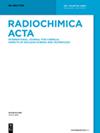土壤无压烧结玻璃复合材料的特性及其在作为废物形式的铀污染土壤中的应用
IF 1.7
3区 化学
Q4 CHEMISTRY, INORGANIC & NUCLEAR
引用次数: 0
摘要
在运行和拆除处理铀的核设施时,周围的土壤可能会受到污染,因此需要对土壤废物采取适当的处理和处置方法。这项研究评估了铀污染土壤废物的高温烧结技术,以克服现有去污方法的局限性和当前固化技术带来的体积增加问题。研究发现,烧结过程能有效地使土壤中复杂的化学成分玻璃化和再矿化。烧结体是在不同条件下生产的,需要调整成型压力、加热温度和时间。优化条件下烧结体的体积减小率超过 30%,抗压强度超过 10 兆帕,这表明烧结体对淤泥和粘土矿物的相转化和再矿化具有重要影响。通过全面的显微观察和矿物相变分析,确定了土壤烧结机制。对模拟铀污染土壤烧结体的浸出评估表明,烧结体适用于受污染的土壤废物。此外,研究还证实,通过加入少量 B2O3 可以降低土壤的烧结温度,从而提高处理过程的经济可行性。这项研究的结果凸显了基于玻璃复合材料的无压烧结技术的适用性,该技术能够同时减少和稳定铀污染土壤废物。本文章由计算机程序翻译,如有差异,请以英文原文为准。
Characterization of glass composite material by pressureless sintering of soil and its application to uranium contaminated soil as a waste form
When operating and dismantling a nuclear facility that handles uranium, the surrounding soil may be contaminated, emphasizing the need for appropriate treatment and disposal methods for soil waste. This study assessed high-temperature sintering technology for uranium contaminated soil waste to overcome limitations in existing decontamination methods and the volume increase associated with current solidification technology. The sintering process was found to effectively vitrify and re-mineralize complex chemical components in the soil. Sintered bodies were produced under varying conditions, adjusting molding pressure, heating temperature, and time. Optimized conditions resulted in sintered bodies with a volume reduction rate exceeding 30 % and a compressive strength surpassing 10 MPa, indicating a significant impact on the phase conversion and re-mineralization of silt and clay minerals. The soil sintering mechanism was identified through comprehensive microscopic observations and mineral phase change analysis. Leaching evaluations of sintered bodies, made from simulated uranium-contaminated soil, demonstrated their applicability to contaminated soil wastes. Additionally, it was confirmed that the sintering temperature of the soil could be lowered by incorporating a small amount of B2 O3 , suggesting a means to enhance the economic feasibility of the treatment process. The findings of this study highlight the applicability of pressureless sintering technology, based on glass composite materials, capable of simultaneously reducing and stabilizing uranium-contaminated soil waste.
求助全文
通过发布文献求助,成功后即可免费获取论文全文。
去求助
来源期刊

Radiochimica Acta
化学-核科学技术
CiteScore
2.90
自引率
16.70%
发文量
78
审稿时长
6 months
期刊介绍:
Radiochimica Acta publishes manuscripts encompassing chemical aspects of nuclear science and technology.
 求助内容:
求助内容: 应助结果提醒方式:
应助结果提醒方式:


